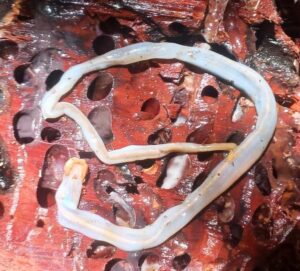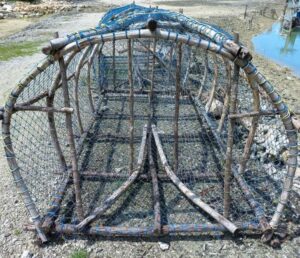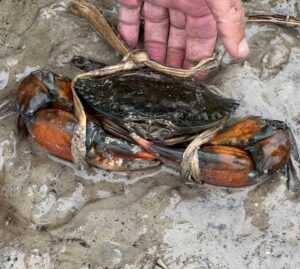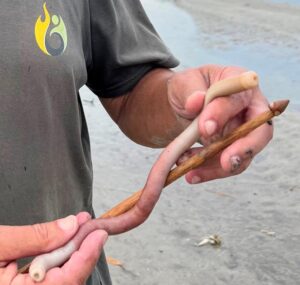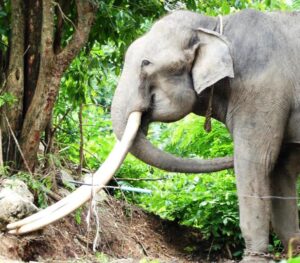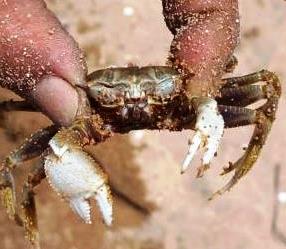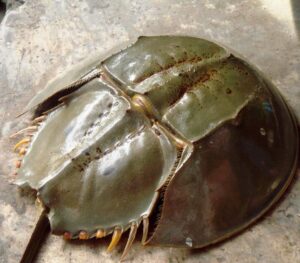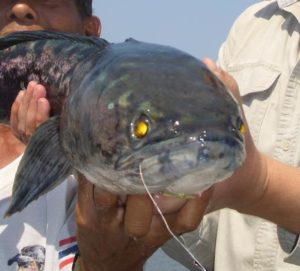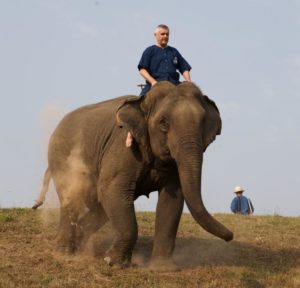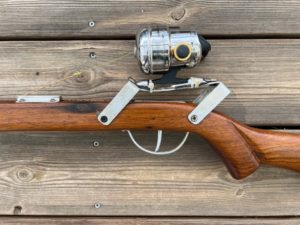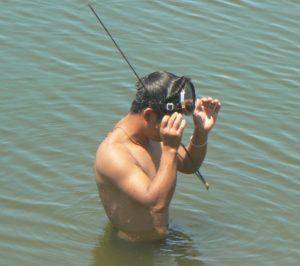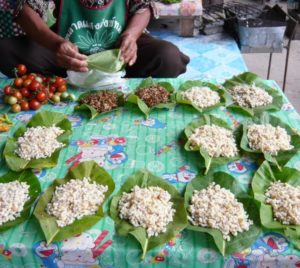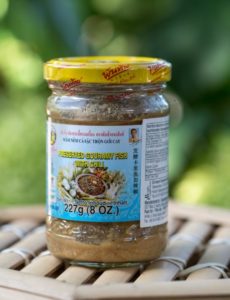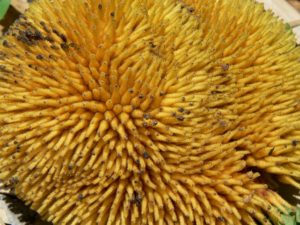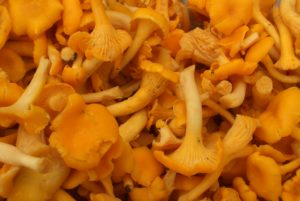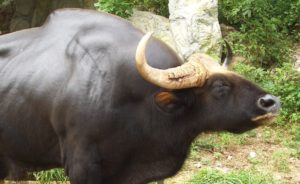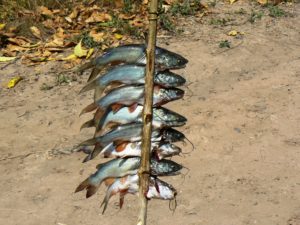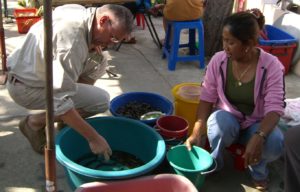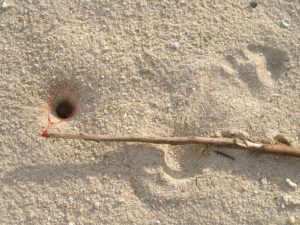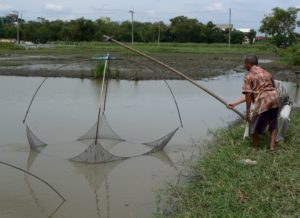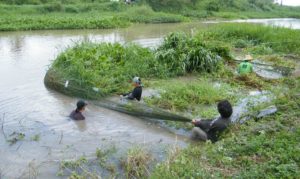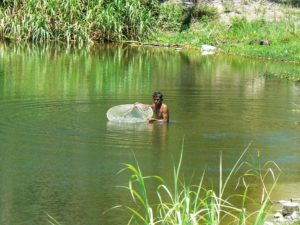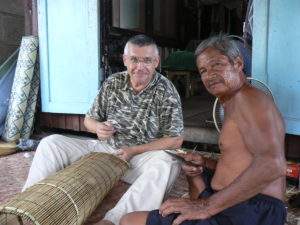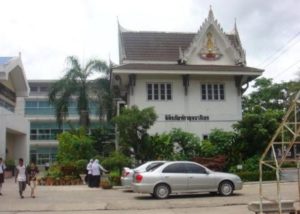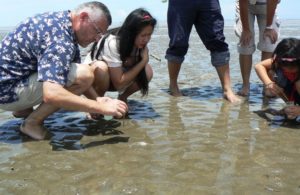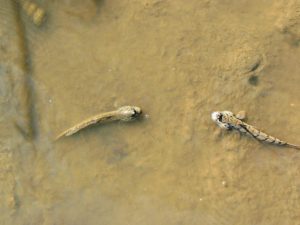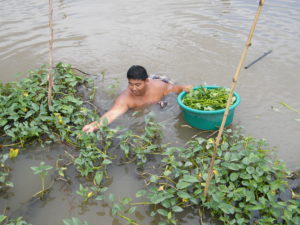Thailand
Harvesting Shipworms in a Thai Mangrove Forest
Edible shipworms, in this case Bactronophorus thoracites, are also known as Naked clams, Priyang talay (เพรียงทะเล), and various other common names throughout the region where they occur. They bore into wood immersed in salt water and are a major hassle…
Collecting Pipi clams at Rawai Beach
Pipi clams (Donax deltoides) are also known as Surf clams, Sandy Donax, and a wide range of other common names. In Thailand, they can be found on most beaches in the Gulf of Thailand and the Andaman Sea. They are…
Bottom fish traps of the Urak Lawoi people
The following information was gathered from a Urak Lawoi man who has lived in the Rawai Beach Sea-Gypsy Village for 27 years. He was 57 years old and only had one tooth (incisor) left in the middle of his upper…
Rectangular squid traps in Thailand
Rectangular squid traps are used in the Gulf of Thailand and along the coastline of the Andaman Sea in the same way as semi-circular traps. Both types are primarily used for catching Bigfin reef squid (Sepioteuthis lessoniana) but will also…
Catching mud crabs at Koh Lanta
Mud crabs are common in mangrove areas in Thailand. They are primarily caught in crab pots for commercial purposes. However, my Urak Lawoi friends and I specialized in digging up and catching these crabs by hand. Who are Urak Lawoi…
Collecting Bibi worms on Koh Lanta
Bibi worms (Sipunculus nudus Linnaeus, 1776) belong to the Peanut worm phylum. They can be dug up at the intertidal zone of flat, sandy beaches on temperate and tropical beaches. These worms are primarily used as top fishing bait. At…
Danger of Asian elephants – whether they are in musth or not
Asian elephants (Elaphas maximus) are smaller than their African cousins but not less dangerous when in musth. That danger was already described for African elephants in this article on this website. In the following, we briefly compare the differences between…
Catching Octopuses by Sea-Gypsies
Sea-Gypsies – Urak Lawoi, Moklen, or Moken – traditionally catch octopuses along the Andaman Sea’s rocky shores. Using a metal skewer and baited bamboo stick, they locate octopuses in holes with foam or clean pebbles. Patiently baiting them, they impale…
Catching Ghost crabs by digging
Ghost crabs (genus Ocypode) comprise 22 different species and they are commonly also called `Sand crabs`. The scientific name Ocypode has got Greek origin and means swift-footed. Generally, Ghost crabs are semi-terrestrial crabs and dig deep burrows in intertidal zones…
Utilizing Horseshoe Crabs as a Food Source
Foreword Horseshoe crabs are a not protected species in Thailand and are experiencing a significant decline. Their primary habitats, particularly the mudflats around mangrove forests, where they live and reproduce, are diminishing, and there is a growing demand for edible…
Giant Snakehead fishing in Thailand
The Giant Snakehead fish (Channa micropeltes) is a highly aggressive and predatory freshwater fish. Its diet mainly consists of smaller fish, frogs, crustaceans, and other aquatic prey. In Malaysia, Singapore, and Indonesia, this fish is known as the ‘Toman’ and,…
Mahout training at Lampang province
The National Elephant Institute of the Forest Industry Organization of Thailand conducted mahout training for amateurs near Lampang. This institute was originally established as a training center for elephants working in the timber industry, where they learned how to lift,…
Semi-Dried Fish in Thailand
In Thailand, both sea and freshwater fish are dried to increase their shelf life for later consumption by humans. Before the advent of refrigeration, the primary method for preventing spoilage was to salt the fish and then leave it in…
Description of a speargun for freshwater fishing
In the following, we will briefly describe a specific speargun for freshwater fishing, which I bought from a fisherman in the northern suburbs of Bangkok, Thailand. It is neither as primitive as many of these guns are, nor is it…
Mechanically propelled spears for freshwater fishing
Mechanically propelled spears for freshwater fishing are common all over Thailand. As many people are crafting these devices themselves, there is a wide variety of principles, styles, and designs. Besides homemade spearguns, where every piece is unique, there is also…
Weaver ants got interesting traits
Weaver ants of the genus Oecophylla consist of two different species. One species is Oecophylla longinoda, which occurs in equatorial, tropical African regions. The other species is Oecophylla smaragdina, which is distributed in tropical Asia and Australia. Both of them…
Pla Ra – Thailand’s fermented fish condiment
Pla Ra (Thai: ปลาร้า, pronounced [plāː ráː]), is fermented fish. It is the traditional way, Thais in central provinces and the northeast (Isan province) are eating fish and rice. In these rather poor provinces, there is only one rice growing…
Marang fruits in Southeast-Asian Rainforests
There are several local names for the tree and fruits of Artocarpus odoratissimus. In English, it is simply called ‘Marang’, which is based on the Philippines’ common name for the fruit. Originally endemic to the region around Mindanao, Sarawak, Kalimantan,…
Jujube trees at Ayutthaya in Thailand
The Ayutthaya Historical Park covers the ruins of the old city of Ayutthaya, which was founded already in 850 AD by the Khmer and named after the Hindu holy city of Ajodhya. It was destroyed by the Burmese in 1767…
Chanterelle mushrooms in Thailand
Thai chanterelles, or more specifically Cantharellus minor live in symbiosis with Gurjun trees (Diopterocarpus tuberculatus) in semi-deciduous Southeast-Asian forests. These trees are easy to identify due to their double-winged (dio-ptero) fruits with big seeds. Besides Cantharellus minor, other species of…
Taste of Gaur meat at Kaeng Krachan rainforest
We were on a weeklong trail through the Kaeng Krachan rainforest, near Hua Hin in Thailand, when we tasted Gaur meat. Together with two National Park (NP) rangers, we came across a freshly died Gaur heifer. This Gaur (Bos gaurus)…
Spit roasted mid-sized fish in Thailand
Fish longer than about 20 cm and not having a snake-like shape, are typically spit-roasted in Thailand. As seen in the photos below, these are mainly Pla Dabian (Barbonymus gonionotus), Pla Chon (Channa striata), and Pla Sawai (Pangasianodon hypophthalmus) but…
Grill spit for small fish
Grill spit for small fish outdoor cooking on a spit Smaller fish of up to about 20 cm in length are typically put on to a grill spit, which is just a split stick. Often in Thailand, this will be…
Freshwater snails for food
In Thailand, two types of freshwater snails are commonly consumed. The first group is comprised of the larger Apple snails (Pomacea canaliculata), while the other group is simply referred to as Freshwater snails (Sinotaia sp. & Filopaludina sp.). Both of…
Jellyfish for food and its preparation
Edible jellyfish (Aurelia sp.) is called ‘Maeng krapun jarn’ (Gulf of Siam) or ‘Lodchong’ (Andaman Sea) in Thailand. Normally there are about three months a year, where these jellyfish for food preferable appear. During this jellyfish run, sea fishermen earn…
Squid traps in the Gulf of Thailand
Squid is a main source of income for many fishermen in villages around the Gulf of Thailand. Because fish are becoming increasingly rare, whereas Cephalodoans maintain their population. Only certain types of finfish are sold profitably, and the rest are…
Catching and holding live eels
The Asian swamp eel (Monopterus albus), called Pla Lai in Thailand, is used as a food source and also for offerings to the spirit deities. When still slim and young, eels are sold to the Buddhist local population for doing…
Crab snare at Koh Samui
Simple crab snare for use on a tropical beach A crab snare comes normally in the shape of a bait cage with about six snares around. This set-up is used in combination with either a fishing line and rod or…
Ricefield shrimps for food
Freshwater prawns (Macrobrachium lanchesteri), also called ‘Ricefield shrimps’ or ‘Goong foi’ in the Thai language, live in every permanent water body in Thailand in big numbers. They are the main food source for a variety of fish and other predators,…
Hand lifting net (Yor lek) in Thailand
Small lift net for catching daily meals of freshwater prawns and fish ‘Yor lek’ is a hand lifting net, and means in Thai language something like ‘small lift net’. ‘Yor’ means ‘lift net’ and ‘lek’ means ‘small’. Its big brothers…
Cast net throwing technique
Description of cast nets used in Thailand Cast nets in Thailand are available in different radii models – I prefer such with a radius of 3,5 meters. 3,5 meters from the center of the net to the outer axial rim…
Small catfish got dangerous spines in Thailand
There is a variety of small catfish species with dangerous spines living in Thai waters. One, a very abundant one, is locally called Pla Kod (Hemibagrus wyckioides); English common name: Asian Redtail Catfish; Thai name: ปลากด. The typical length for…
Circumferencing water plants to catch fish
Most Thai water channels, khlongs, and streams are clogged with a variety of water plants, predominantly Common Water Hyacinth (Eichhornia crassipes). This invasive species was introduced in 1901 by Thai Royalty from Indonesia and was supposed to be eradicated by…
Hand net fishing
Hand nets, equipment, and technique For hand net fishing, mosquito netting is used to sieve water bodies for rice fields shrimps, and fish fry in Thailand. In order not to lose caught animals, the netting was brought into a deep,…
Crafting a bamboo fish trap in Thailand
Learning the craft of bamboo fish trap weaving The correct English wording for a ‘Lop’ in the Thai language would be ‘Horizontal cylinder trap with entry cone’. It is used for catching a variety of freshwater fish and crustaceans, including…
Bank line fishing in Southeast Asia
The term ‘Bank line’ used in English to refer to a string of poles along a water bank is virtually unknown in Southeast Asia. Instead, this fishing method and its equipment are referred to by different names in the region….
Donation of a fish trap collection
A new home for over 100 different fishing traps and implements After leaving Thailand for an assignment in China it was difficult to find the right place for my fish trap collection. Originally, I wanted to open up some kind…
Razor clams collection with quicklime
A mudflat full of razor clams ‘Don Hoi Lot’ is a mudflat in the Thai Province of Samut Songkhram with a size of about 15 km2 (about 9 square miles). ‘Don’ means ‘mudflat’ in English. ‘Hoi’ means ‘clam’ and ‘Hoi…
Harvesting and opening Nipa Palm fruits
Nipa palms (Nypa fruticans) are a species of palms especially adapted to muddy environments of slow-moving tidal waters and mangrove forests and occur in Asia-Pacific tropical climates. And Nipa palm fruits are delicious to eat. Both, fruits, and wooden parts…
Mudskippers for food
In Thailand live a variety of mudskipper species, notably Giant mudskippers (Periophthalmodon schlosseri), Blue-spotted mudskippers (Boleophthalmus boddarti), and others. All of them are amphibious fish, that live on muddy estuary- and tidal brackish river zones all around Asia-Pacific. They live…
Morning glory – a valuable wild vegetable in Asia
Swamp morning glory or Water spinach (Ipomoea aquatica) has a variety of common names, like ‘Kangkong’ in Southeast Asia or ‘Kung Shin Tsai’ in China. It is a staple vegetable food throughout Asia-Pacific. And it is very low in calories…

